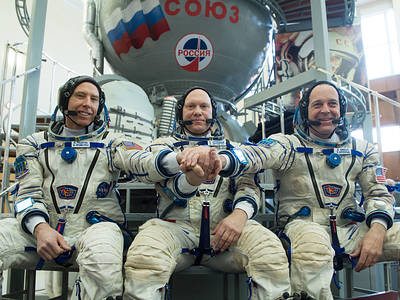 Photo courtesy of: National Aeronautics and Space Administration
Photo courtesy of: National Aeronautics and Space Administration
NASA’s Reliance on Russia’s Roscosmos and Upcoming Collaboration
Despite a tense relationship during and after the Cold War, space exploration has been one of the greatest areas of cooperation between the United States and Russia. Collaboration began with the Soviet Union in the 1970s with the Apollo-Soyuz Test Project. In 1993, an agreement was made between the European, American, Russian, Japanese, and Canadian space programs to create the International Space Station (ISS). In 1995-1998, the Shuttle-Mir program flew American astronauts to Russia’s Mir space station, putting a foundation in place for the ISS partnerships. This cooperation continued throughout the 1990’s and 2000s when the ISS was completed and occupied. After the U.S. retired its Space Shuttle program in 2011, it became reliant on Russia to send American astronauts to the ISS, replenish supplies, and since the mid-90s has consistently used Russian-made engines for its rockets.
Since the Soviet Union, Russia’s space program has been militarily focused, but there is no clear agenda for the civilian space sector. Other than maintaining Soviet-era defense capabilities, Russia does not see political importance to do more. Some experts are predicting that without strategic military importance, Russia’s space program, Roscosmos, would deteriorate. It is currently placed third, behind the U.S. and China, has not earned as much as planned in selling engines and launch services, and senior officials say the program is failing. It does have a monopoly on manned flights, allowing it to maintain its global importance in space exploration. Its Soyuz-FG is the only spacecraft still being used to bring astronauts and cosmonauts to the ISS.
In 2015, President Vladimir Putin dissolved the Federal Space Agency and formed a state-run corporation, under the same name, Roscosmos. In doing this, he was hoping to improve the program’s (and Russia’s) competitiveness. After a 10-year budget was approved in 2016, Roscosmos determined its areas of focus will be in satellites, competing with commercial development, and lunar missions. There are plans for a rocket similar to SpaceX’s Falcon 9 Heavy but the designs are not finished and it is not scheduled to launch until 2028, putting Russia well behind the U.S. and commercial space programs. Despite these goals, it is assumed that institutional problems, corruption, and a budget decrease will largely limit Roscosmos from maintaining its competitive edge in the coming years.
The National Aeronautics and Space Administration (NASA) has been working to decrease dependence on Russian launches, both manned and unmanned. Following the retirement of the Space Shuttle and rise of commercial success, NASA began using SpaceX’s Dragon spacecraft and Orbital ATK’s Cygnus spacecraft to resupply the ISS. NASA also has a partnership with Boeing and SpaceX called the Commercial Crew Program to develop spacecraft meant to transport humans, a step away from continuing to use the Soyuz. There is already a contract for manned flights to the ISS scheduled to begin in 2019.
With the U.S.’ plans to end funding for the International Space Station by 2025, both the White House and Congress have given directions for NASA to focus on missions to the Moon, working towards the Deep Space Getaway, a project planned with Russia for a space station in lunar orbit. This plays into a larger goal of getting humans to Mars. In his speech to the National Space Council, Vice President Mike Pence has expressed wanting the U.S. to be dominant in space while continuing international cooperation and collaboration.
The agreement on the Deep Space Getaway shows that the long-standing space collaboration with Russia will not end after the ISS program does. There will, however, be a shift in relationship between the U.S. and Russia as private companies continue to excel and improve in space exploration. As new missions outside of low-Earth orbit become more frequent and both countries work towards a cis-lunar space station, it is in NASA’s best financial interests to find cheaper means for sending astronauts to space. NASA will have more options in the coming years with its own new rockets and the commercial market, giving it the ability to end its dependence on Roscosmos. Having this foreseen domination can reverse the current roles of the U.S. and Russia, with Russia purchasing seats on American spacecraft, ultimately benefitting American industry and competitiveness in the space sector.





